Setting up a foolproof home security system from scratch needs careful planning. A comprehensive security plan is key to keep your home and family safe.
It’s more than just cameras and alarms. You need a complete home security system that works together. This means figuring out your home security needs and picking the right home security package.
Key Takeaways
- Assess your home security needs before setting up a security system.
- Choose a home security package that fits your situation.
- Integrate various components for maximum protection.
- Careful planning is key for a foolproof security system.
- A detailed security plan is vital to protect your home and family.
Understanding the Importance of Home Security
Home security is key in today’s world. It’s not just about protecting your home. It’s about keeping your family safe and sound.
Why Invest in a Complete Home Security System?
A complete home security system offers many benefits. It deters intruders and gives homeowners peace of mind. It includes advanced security solutions like cameras, alarms, and smart locks.
Here are some key benefits:
- It boosts protection against burglary and vandalism.
- It offers real-time monitoring and alerts.
- It works with smart home devices for easy control.
- It might lower your home insurance costs.
For more info on home security, check out https://solarkiit.com/2025/05/03/home-security/. There, you can find various options and expert tips.
Common Threats to Home Security
Home security threats are many and serious. They can harm your home and family if not stopped. Some common threats are:
- Burglary: Breaking into a home to commit a crime.
- Vandalism: Intentionally damaging or destroying property.
- Identity theft: Using someone’s personal info without permission.
A residential alarm system is vital in fighting these threats. A strong security system can greatly lower the chance of these crimes happening.
Key Components of a Complete Home Security System
A home security system needs several key parts to protect well. These parts work together to keep your home safe from many dangers.
Types of Security Cameras
Security cameras are key for any home security system. There are wired and wireless cameras. Wired cameras are more secure but need a wire. Wireless cameras are easier to set up but might not be as stable.
When picking cameras, think about resolution, field of view, and night vision. Good cameras should have high resolution, cover a wide area, and work at night.
- High-resolution cameras for clear images
- Wide-angle lenses for broader coverage
- Night vision for 24/7 surveillance
Door Locks: Smart vs. Traditional
Door locks are also very important for home security. Smart locks have cool features like keyless entry and remote monitoring. On the other hand, traditional locks are simple and don’t need electricity.
Choose between smart and traditional locks based on what you need and like.
- Smart locks for enhanced convenience and security
- Traditional locks for simplicity and reliability
Alarm Systems Overview
Alarm systems help deter and respond quickly to threats. Today’s alarm systems can be wired or wireless. They often have motion detectors and glass break sensors.
These systems can be watched by security companies or by you through apps.
Monitoring Services Explained
Monitoring services add more security by quickly responding to alarms. There are professional monitoring and self-monitoring options. Professional monitoring means security people handle alerts. Self-monitoring lets you handle them yourself.
- Professional monitoring for quick response
- Self-monitoring for personal control
Assessing Your Home’s Security Needs
Understanding your home’s security needs is key to a good automated security system. You need to know your home’s weak spots and where more security is needed.
Conducting a Home Security Audit
A detailed home security audit is vital. It helps you see how secure your home is. Check your home’s edges, like doors and windows, for any weak spots.
Focus on the locks’ condition, hidden entry points, and how visible your home is to intruders.
Look at your home’s lighting, inside and out. Good lighting can scare off intruders. Also, check your current security, like alarms and cameras, to see if they need updates.
Identifying Vulnerable Areas
Finding weak spots in your home is important for better security. Look for unlocked doors and windows, dark spots, and hidden entry points. Once you find these, you can start fixing them.
You might need to get new locks, add more lights, or put up security cameras. Fixing these weak spots will make your home safer and lower the chance of break-ins.
Building a Comprehensive Security Plan
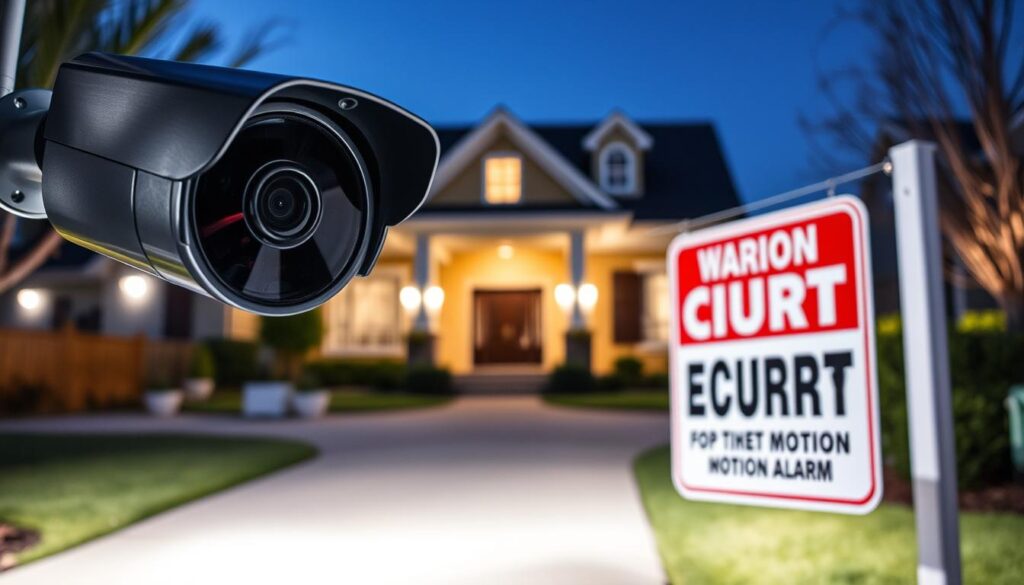
A good security plan is key to a safe home. It checks your home’s weak spots and adds security steps to lower risks.
To begin, you need to set clear security goals. Think about what you want from your security system. Do you want to scare off burglars or get help fast in an emergency? Knowing your goals helps pick the right gear and services.
Establishing Clear Security Goals
Clear goals are the base of a solid security plan. To set these goals, follow these steps:
- Look at your home’s specific security needs.
- Spot any weak spots.
- Decide how much security you need.
If you live in a crime-prone area, you might need a strong burglar deterrent system. This could include outdoor cameras and lights that turn on when someone moves.
Integrating Technology into Your Plan
After setting your goals, it’s time to add technology to your plan. Choose the right security gear and make sure it all works well together. For more help on making a detailed security plan, check out evaluating security needs.
Today’s security systems use smart tech like sensors, wireless links, and apps. These tools make your security plan better and help you act fast if danger comes.
Selecting the Right Security Equipment
Choosing the right security equipment is key to a safe home. A good security system can scare off intruders and give you peace of mind.
There are many things to think about when picking security gear. What you choose depends on your home’s size, where it is, and any past security issues.
Cameras: Indoor vs. Outdoor
Security cameras are a must-have for any home. You need to pick between indoor and outdoor cameras. Indoor cameras watch the inside of your home. Outdoor cameras can handle the weather and catch footage outside.
Outdoor cameras have night vision and motion detection. They’re great for spotting intruders. Indoor cameras are good for keeping an eye on places like nurseries or living rooms.
| Camera Type | Features | Best Use |
|---|---|---|
| Indoor Cameras | Discreet design, motion detection | Monitoring interior spaces |
| Outdoor Cameras | Weather-resistant, night vision | Securing exterior premises |
Alarm Systems: Wired vs. Wireless
Alarm systems are also essential for home security. You can pick between wired and wireless systems. Wired systems connect to your home’s electricity. Wireless systems run on batteries or solar power.
“Wireless alarm systems offer greater flexibility and are easier to install, but they may be more vulnerable to interference. Wired systems, on the other hand, are more reliable but can be more complicated to install.”
When choosing, think about your home’s setup and your security needs.
Choosing the Best Door Locks
Door locks are a basic part of home security. You can go for smart locks or traditional ones. Smart locks have cool features like keyless entry and biometric scans. Traditional locks are simple and don’t need tech.
Smart locks can link up with your security system for remote access. Traditional locks are cheaper and don’t need batteries or internet.
DIY vs. Professional Installation
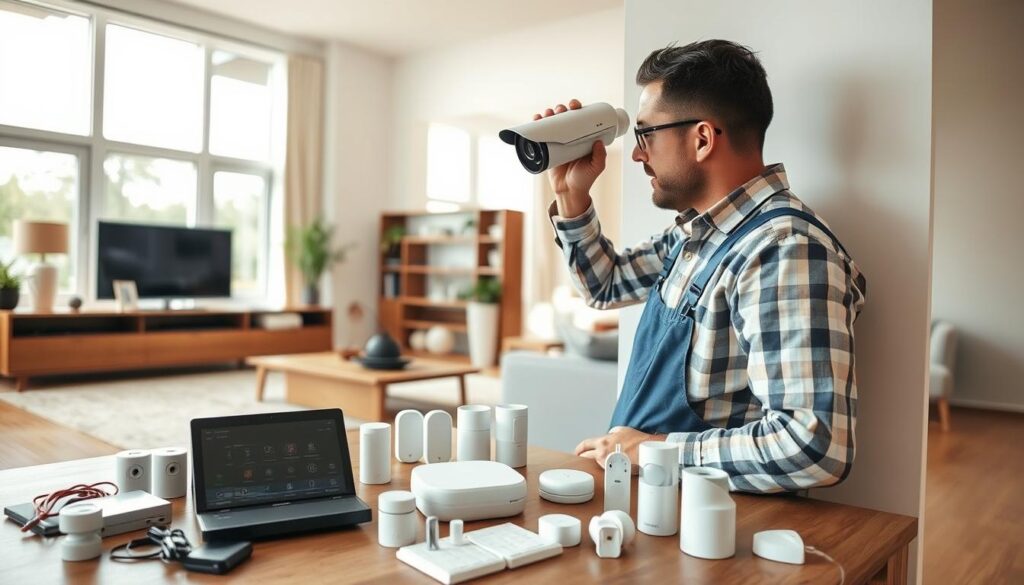
Choosing between DIY and professional installation for your home security is important. It affects how well and efficiently your system works. Your skills, budget, and the system’s complexity play a big role in this decision.
Professional installation has many benefits, mainly for complex systems. Experts can figure out what security you need and suggest the best options. They also make sure the system is installed right, avoiding future problems.
Benefits of Professional Installation
Professional installation means your system is set up right. Experts know how to handle complex setups, making sure everything works together well. Many companies also offer monitoring services as part of their professional installation packages, adding more security.
The main advantages of professional installation are:
| Benefit | Description |
|---|---|
| Expertise | Professionals know how to install systems correctly and efficiently. |
| Time-Saving | They do the installation fast, saving you time and effort. |
| Warranty and Support | Many companies offer warranties and dedicated support for professionally installed systems. |
Steps for DIY Setup
If you like doing things yourself, DIY installation might work for simpler systems. The steps include:
- Figuring out what security you need and picking the right equipment.
- Following the manufacturer’s instructions for installation.
- Testing the system to make sure everything is working right.
DIY can save money upfront, but it might lead to mistakes and take a lot of time. For detailed setup instructions, check the manufacturer’s guide or online resources.
In conclusion, choosing between DIY and professional installation depends on your needs, comfort with technology, and budget. Weighing the pros and cons helps you decide what’s best for your home’s security system.
Setting Up Cameras Effectively
A well-planned camera installation is key to any smart home security system. It’s important to place cameras strategically around your home. This ensures maximum coverage and effectiveness.
Placement Tips for Maximum Coverage
Think about the areas of your home most at risk of intruders. This includes doors, windows, and any blind spots around your property.
Cameras should be set up at different heights and angles. For example, having cameras at ground level and higher can capture more details. This includes facial recognition and license plate numbers.
Utilizing Motion Sensors
Adding motion sensors to your camera system boosts your home’s security. These sensors can turn cameras on when they detect movement. This cuts down on unnecessary footage and helps spot threats faster.
Today’s automated security systems also send alerts to your phone or tablet when motion is detected. This lets you act quickly if there’s a security issue.
By using smart camera placement and motion sensors, you can build a strong home security system. It offers peace of mind and better protection for your family and property.
Choosing an Alarm System
An effective alarm system is key to a strong home security setup. It keeps intruders away and ensures quick help in emergencies.
Evaluating Different Types of Alarms
When looking at alarms, think about the type, its features, and if it fits with your current security. A burglar deterrent system is great because it has loud sirens and bright lights to scare off intruders.
There are many alarm systems out there, including:
- Wired alarm systems that connect to your home’s electrical system
- Wireless alarm systems for easier setup and more flexibility
- Smart alarm systems that you can control and check on your phone
How to Select the Right Monitoring Service
Choosing the right monitoring service is key for a good alarm system. Look for one that monitors 24/7 and responds fast. Also, think about the cost and any extra fees.
For more tips on picking the best home security, check out CNET’s guide on the best home security.
| Monitoring Service Features | Basic | Premium |
|---|---|---|
| 24/7 Monitoring | Yes | Yes |
| Response Time | Under 1 minute | Under 30 seconds |
| Additional Fees | $10/month | $20/month |
| Smartphone App | No | Yes |
By carefully looking at different alarms and picking the right monitoring service, you can make an all-in-one security system. This system will protect your home and family well.
Integrating Smart Home Technology
Adding smart home tech is key to a full security system. It makes security better and more effective.
Benefits of Smart Security Features
Smart security has many perks. It lets you watch your home from anywhere. It also has voice control and automated lighting for more security and ease.
Smart lights can look like someone’s home, even when no one is there. This can scare off intruders. Plus, it works well with other smart devices, like thermostats and locks.
Compatible Devices for a Complete System
To have a full smart home security system, you need several devices. These include cameras, door sensors, and alarm systems. Make sure they work together and with your smart home.
For more info on linking home automation with security, check out ADT’s guide. Also, see Solarkiit’s review of the best alarm systems to pick the right ones for you.
| Device Type | Features | Benefits |
|---|---|---|
| Smart Security Cameras | High-definition video, night vision, motion detection | Enhanced surveillance, deterrent to intruders |
| Smart Door Locks | Keyless entry, biometric authentication, remote access | Increased convenience, improved security |
| Smart Alarm Systems | Motion sensors, door sensors, loud sirens | Immediate response to threats, alerts homeowners |
Best Practices for Home Security Maintenance
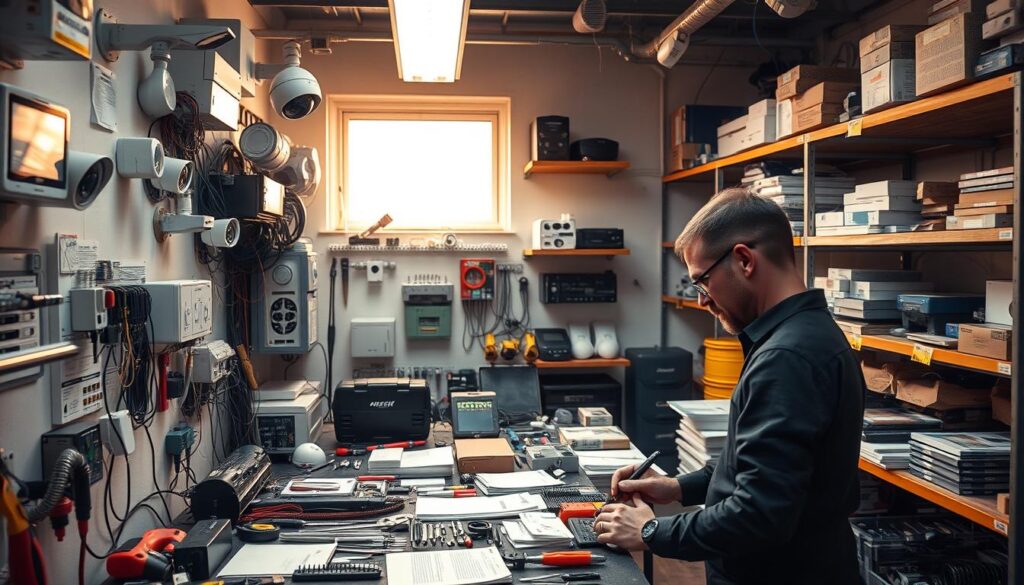
Keeping your complete home security system in good shape is key to your home’s safety. Regular upkeep extends your equipment’s life and keeps it working right when you need it.
To keep your system running smoothly, focus on both hardware and software. This means doing regular checks and updating your security software.
Regular System Check-ups
Regular checks are essential to catch problems early. You should check your security system’s parts, like cameras, locks, and alarms, to make sure they work well.
- Check cameras for clear views and right placement.
- Test door locks to make sure they’re secure and work right.
- Make sure alarm systems sound loud and clear.
For more info on choosing the right home security companies, visit https://solarkiit.com/2025/05/03/home-security-companies/. There, you can find various options and reviews.
Keeping Software Updated
Updating your security system’s software is critical for staying safe from new threats. Advanced security solutions need updates to fix bugs and add new features.
| Update Type | Description | Frequency |
|---|---|---|
| Security Patches | Fixes vulnerabilities in the system | As needed |
| Feature Updates | Adds new features or improves existing ones | Quarterly |
| System Checks | Diagnostic checks to ensure system health | Monthly |
By following these tips, your home security system will stay effective. Regular care is essential for a safe and secure home.
Educating Your Family on Security
To get the most out of your home security package, teach all family members how to use it. Knowing how to protect your home is key. A smart family is your best defense against danger.
Training Family Members on Emergency Procedures
It’s vital to teach family members what to do in emergencies. They should know how to get out safely, who to call, and how to turn on the residential alarm system. Practice drills to make sure everyone remembers.
Choose a spot outside where everyone can meet after leaving the house. This makes it easier to check that everyone is safe.
Importance of Communication
Good communication is essential for home security. Family members should know how to talk to each other in emergencies. This could be through a family contact or a group chat app.
Clear communication helps avoid confusion. It makes sure everyone knows what to do, like using the security system.
- Discuss and agree on emergency protocols.
- Ensure all family members understand how to use the security system.
- Regularly review and update the security plan as needed.
Evaluating Your Security System’s Effectiveness
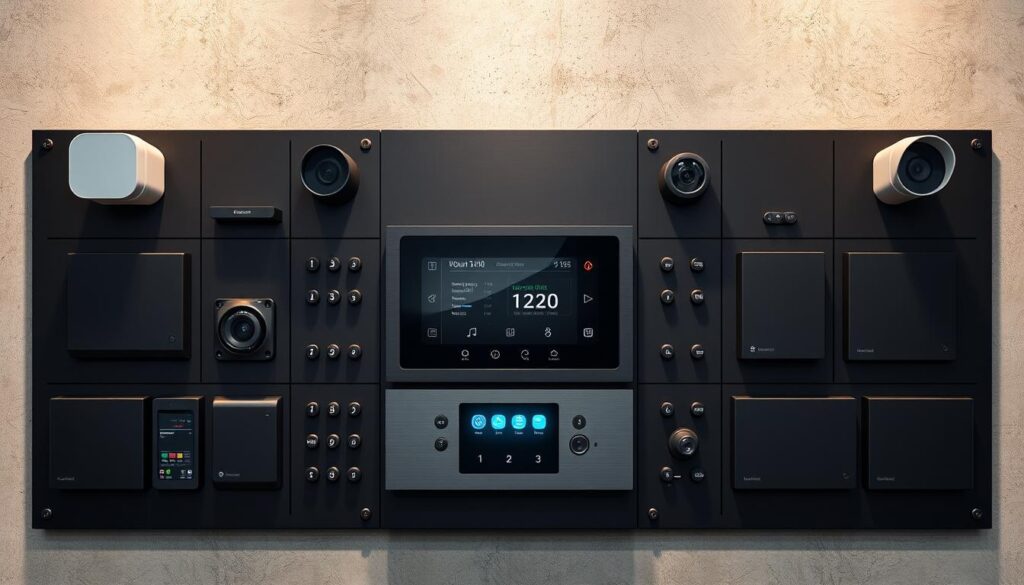
Checking how well your home security system works is key. It helps spot areas for betterment and keeps your family safe.
- Response time: How fast your system reacts to threats.
- False alarm rates: How often false alarms happen, which can be annoying and lower trust in your system.
- System downtime: Any times when your system isn’t working.
Key Metrics to Monitor
Keeping an eye on these metrics shows how well your all-in-one security system is doing. For example, a lot of false alarms might mean you need to tweak sensor settings or train users better.
Knowing When It’s Time to Upgrade
If your system can’t stop burglars or keeps having tech problems, it might be time for a new one. A good burglar deterrent system should work well and reliably. For more on checking your home’s safety, check out our guide on home security audits.
By regularly checking your security system, you make sure it stays a strong burglar deterrent system. This keeps your home and family safe.
The Role of Neighborhood Watch Programs
Neighborhood watch programs are key in making homes safer. They work by having neighbors watch out for each other. This creates a safer community for everyone.
These programs are more than just watching. They are about stopping crime before it happens. Neighbors can spot and stop threats together, making their area safer.
Enhancing Security through Community Involvement
Community involvement is essential for a neighborhood watch to succeed. When people watch their neighborhoods, it scares off intruders. It also helps neighbors use smart home security and automated security systems.
For a watch to work well, members need to know what they’re doing. They should learn about home security, spot suspicious activity, and know how to act. Adding smart home security tools like alerts and cameras makes them even better.
Tips for Starting a Neighborhood Watch
Starting a neighborhood watch needs good planning. Here’s how to do it:
- Find leaders to lead the effort.
- Hold a meeting to see who’s interested.
- Make a clear plan and goals for the watch.
- Set up a way for members to talk to each other, using neighborhood watch resources.
- Work with local police for support and advice.
By following these steps and keeping members involved, neighborhood watches can make their communities safer. They work well with automated security systems to protect homes.
Insurance Benefits of a Home Security System
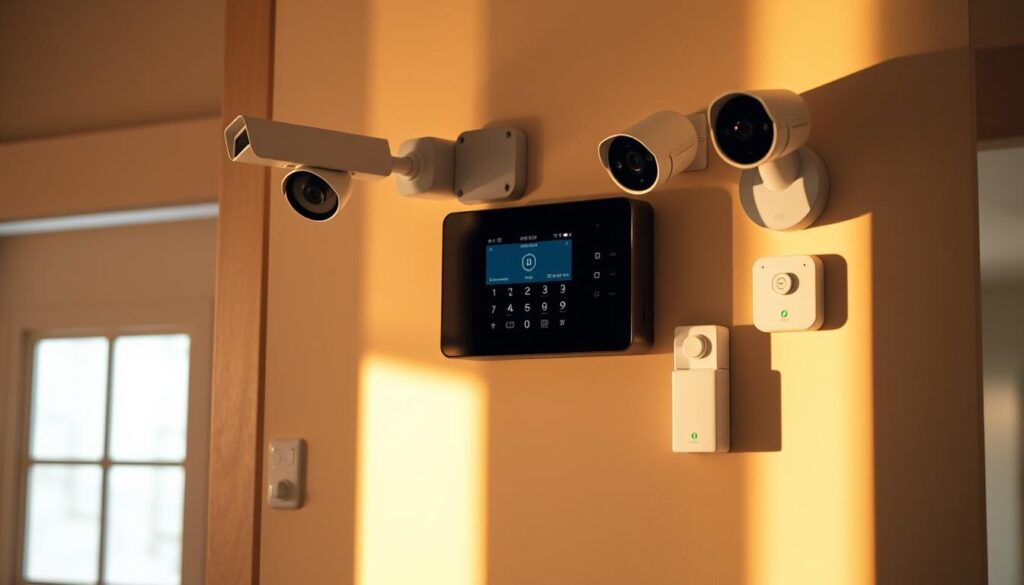
Getting a complete home security system can save you money on insurance. It makes your home safer and offers insurance perks.
Reducing Insurance Premiums
A home security system can lower your insurance costs. It makes your home less likely to be burglarized. Insurance companies see this as a good thing for homeowners.
Key Factors Influencing Premium Reduction:
- Presence of a monitored security system
- Type and quality of security equipment installed
- Regular maintenance and updates of the security system
A study shows homes with security systems are 60% less likely to be burglarized. This means fewer insurance claims and lower premiums for you.
“Homes with security systems are 60% less likely to be burglarized, which can lead to significant savings on insurance premiums.” – Insurance Industry Expert
Documenting Your Security Measures
It’s important to document your home security well. Keep records of your security equipment, maintenance, and any monitoring services.
| Documentation Type | Description | Importance Level |
|---|---|---|
| Equipment Inventory | List of all security devices installed | High |
| Maintenance Logs | Records of regular checks and updates | High |
| Monitoring Service Details | Information about the monitoring service provider | Medium |
Keep detailed records and keep your system updated. This shows insurance providers your home is safe, which can lower your premiums.
Future Trends in Home Security
The world of home security is always changing. It’s key to know about the newest advanced security solutions. The industry is always coming up with new ideas, thanks to new tech and what homeowners want.
For more info on current trends, visit https://www.adt.com/resources/home-security-trends.
Innovations on the Horizon
New things are coming to home security. Think AI-powered cameras, biometric checks, and smart home links. These changes make security systems better and easier to use.
- Artificial intelligence (AI) and machine learning (ML) integration
- Biometric authentication methods
- Smart home device integration
- Cloud-based security solutions
Predicting Future Security Needs
As tech gets better, we need to think about what security will look like next. Homeowners will want more advanced and connected security. A residential alarm system will just be part of a bigger security plan.
For the latest on security systems, check out https://solarkiit.com/2025/05/03/security-systems/.
| Technology | Current State | Future Development |
|---|---|---|
| AI-Powered Surveillance | Basic object detection | Advanced threat analysis and prediction |
| Biometric Authentication | Fingerprint and facial recognition | Multi-modal biometrics and behavioral analysis |
| Smart Home Integration | Basic device control | Seamless integration with security systems |
Conclusion: Your Path to a Safer Home
Creating a foolproof home security system is a detailed process. It requires careful planning, execution, and ongoing maintenance. By following the steps in this article, you can make a complete security plan. This plan will protect your home and family with an effective all-in-one security system.
A strong burglar deterrent system is key to keeping your property safe. Adding smart home technology and 24/7 monitoring services boosts your home’s security a lot.
For reliable home protection, look for systems that monitor for fire, carbon monoxide, and floods. Regular maintenance and support are vital for your security system’s effectiveness. Learn more about complete security solutions on business security systems.
Investing in a complete home security system gives you peace of mind. Your family and property will be safe. Start making your home safer today.




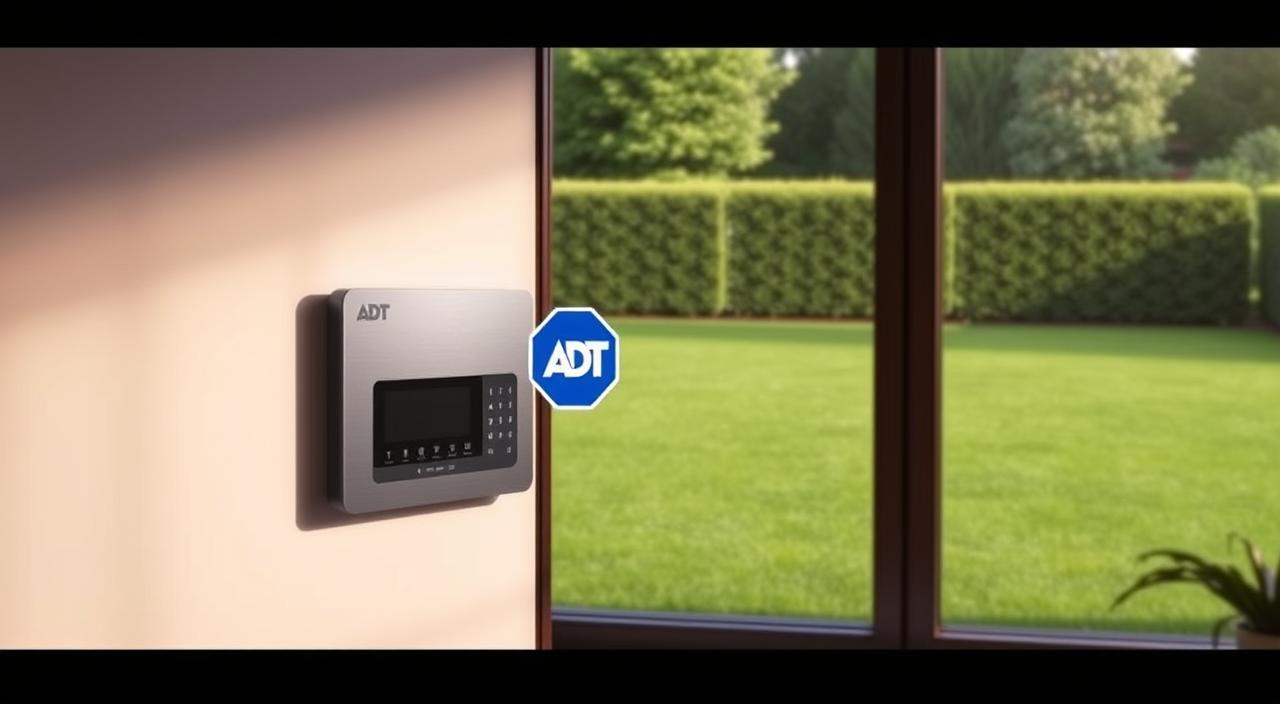
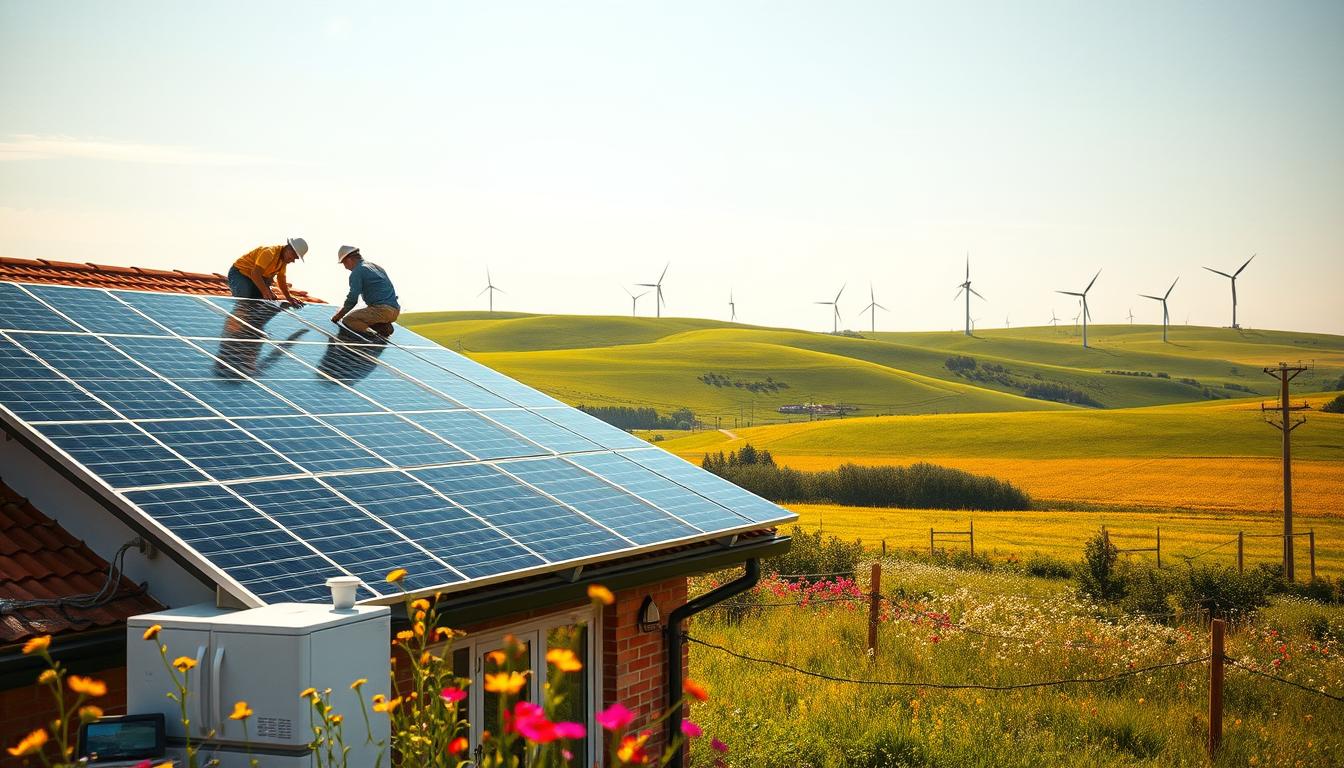
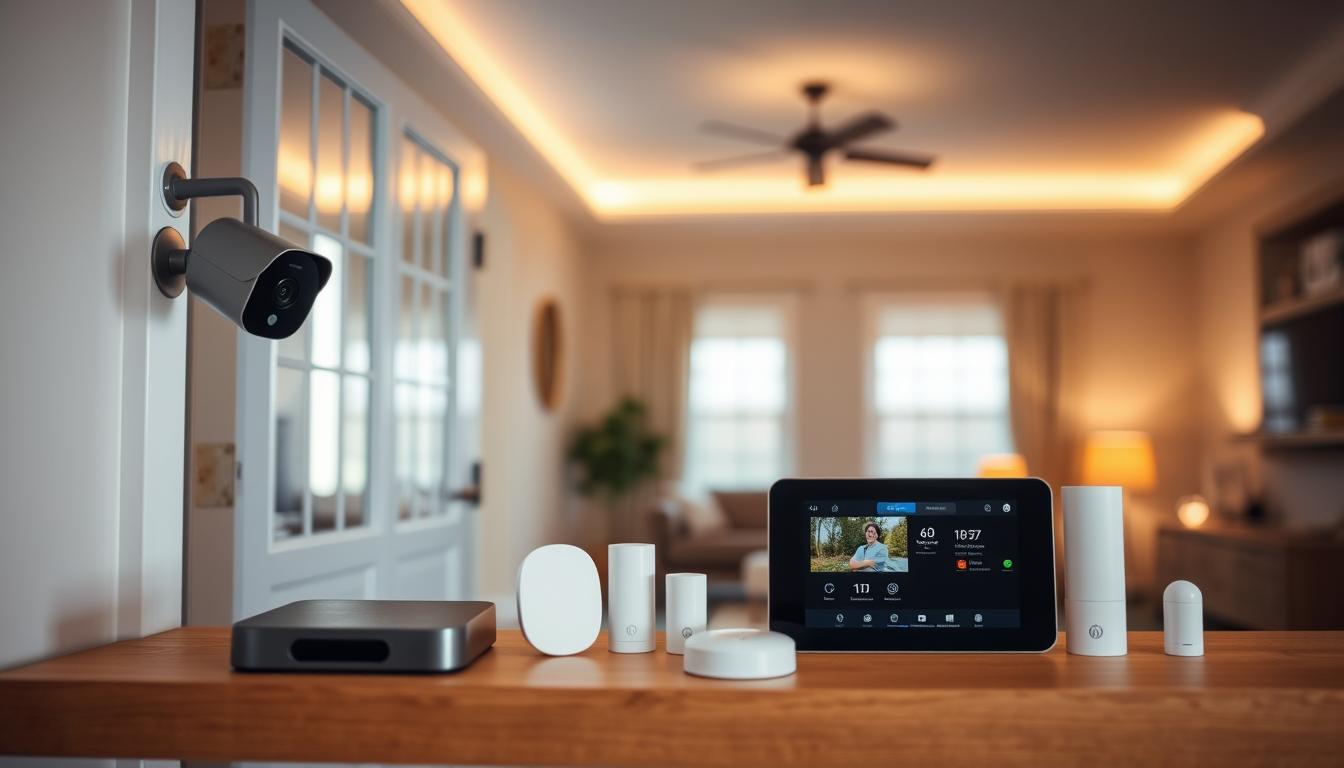
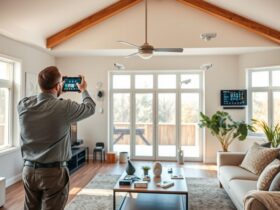
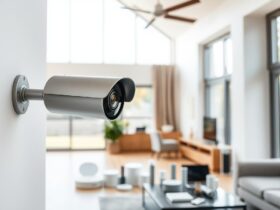
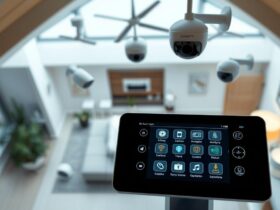
Leave a Reply